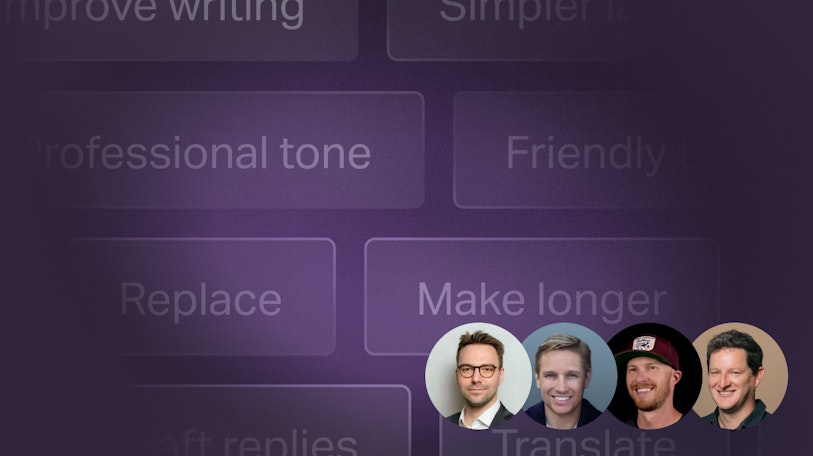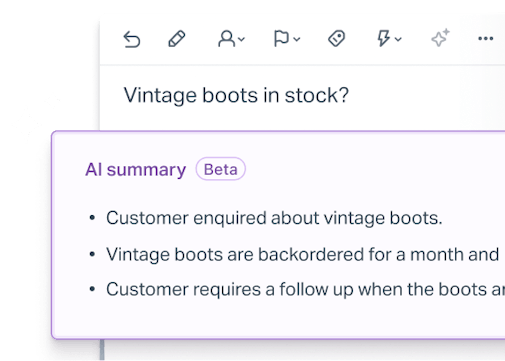The robots have officially arrived, and while it feels like an invasion, we promise they’re here to help. Artificial intelligence (AI) is rapidly transforming customer service, challenging businesses and support teams to keep up with an endless array of emerging tools and trends.
Its most recent trend?
Generative AI has revolutionized chatbots, creating enhanced service channels that aren’t powered by human agents. This new wave of chatbots is becoming more and more popular, changing how customer service leaders have traditionally viewed and leveraged their support tools.
Are you skeptical about chatbots? Still haunted by Clippy?
You’re not alone, and there are plenty of reasons why support experts have historically been wary of chatbots. This article puts some of those troubles to rest and lays out the various reasons why you should consider incorporating a chatbot into your customer experience.
What are chatbots?
Chatbots are a type of software that can simulate human-like conversations and increase the scalability of your customer support operations. While chatbots aren’t new to the world of customer service, the chatbot space is changing quickly with the introduction of generative AI.
There are two main types of chatbots: rules-based chatbots and AI-based chatbots.
Rules-based chatbots
Rules-based chatbots are less Terminator-like and more of Rube Goldberg’s making. You define a series of rules like a decision tree and the chatbot strictly executes them.
For example, you could create a flow that guides customers through a password reset. When they search for the term “password reset,” they’re directed to the documentation or area where they can change their password.
These bots only implement what humans have defined and cannot handle exceptions or nuances. They’re great at fulfilling simple tasks but struggle with things like sentiment analysis, conversational writing, and complex rerouting trees.
AI-based chatbots
The new kids on the block are AI-powered chatbots that do not require a predefined list of rules. They leverage the power of large language models (LLMs) to provide a facsimile of human interaction. In other words, they understand your customer’s natural language inquiries and respond with human-sounding answers.
Understanding the technology behind AI chatbots
The term “artificial intelligence” or AI describes a group of technologies that uses machine learning, large-language models, and other systems to solve problems — this is what powers tools like ChatGPT or Google’s Gemini.
Machine learning refers to algorithms and statistical models used to “learn” from data and make decisions without explicit human instructions on how to do so. Machine learning has a vast array of applications, from fraud detection to recommending your next watch on Netflix. (Spoiler: It’s probably Grey’s Anatomy, again.)
Large-language models (like ChatGPT) are a subset of machine learning that understand and produce natural language. They ingest massive amounts of text from various sources and use that data to predict and produce human-sounding answers. LLMs typically power the AI chatbots used by customer service teams.
The top 10 benefits of implementing chatbots in customer service
Looking back over the last decade or so, chatbots have been a bit controversial in the customer service space.
Companies and customer support leaders often like chatbots because they can help automate a good portion of your repetitive customer inquiries. But customers often express dislike for chatbots because they feel impersonal and can create frustrating dead ends when you’re trying to find help.
But that’s the past. The introduction of generative AI is having a massive impact on the world of chatbots, and it’s making it possible for both customers and companies to see a wide range of benefits. Here are 10 reasons to implement chatbots into your customer service process.
1. Provide 24/7 customer service without overextending your team
While your service team might have working hours, your customers’ problems don’t. They don’t take off nights and weekends, and they expect you to be there when something goes wrong.
Not every business can afford to staff a 24/7 support team. But with an AI chatbot, your team can always provide a response, whether it’s two in the afternoon or two in the morning.
Chatbots provide immediate responses regardless of the time of day — even during holidays and weekends — without having to dramatically expand your team’s headcount.
Generative AI makes this experience even better. Generative chatbots have real conversations with customers, making your support channels even more versatile when your team is out of office. While nothing replaces the precision of a human support rep, you can rest easy knowing your AI-powered chatbot is managing frustrated customers or time-sensitive questions while your team is away.
2. Allow humans to focus on the most complex requests
Chatbots can’t replace your team. In fact, 78% of customer experience leaders say their chatbots aren’t anything akin to digital agents.
What they can do is give your team the space to focus on the most complex requests that require a human touch. Chatbots can take on highly repetitive tasks, freeing up your agents to have an impact in areas where AI just doesn’t cut it.
3. Extend your support across new languages instantly
Chatbots instantly expand your customer base by providing multilingual support. This makes your product much more inclusive because it gives customers the option to choose their preferred language when requesting help. It also removes the need for manual translation tools that are costly and inefficient.
4. Conversationally collect relevant information upfront for your team
Chatbots collect details for your team upfront, engaging customers in natural-sounding dialogue that provides actionable insights about their needs. This improves your ability to route customer conversations, can help enrich your understanding of your customers, and saves valuable time in troubleshooting complex issues.
5. Guide customers to self-service solutions quickly
Customers prefer self-service over all other support channels. But self-service tools like knowledge bases aren’t always easy to navigate and can make it difficult for people to find the best solution to their problem.
Chatbots act as personal secretaries, directing customers to specific support documents based on the information they’re provided. For instance, if I wasn’t sure how to reset my password, a chatbot could send me a knowledge base document that explains how to do this step by step. This creates a more guided experience for the customer without drawing in a human support agent.
6. Provide faster and more responsive service
Customers aren’t always patient — 90% say an immediate response is critical when they have a question. Chatbots surpass expectations by providing lightning-fast responses to customer inquiries. Your bot won’t be overwhelmed by an increase in seasonal demand or spend time idle when volume drops. They’re (literally) a well-oiled machine that’s ready to respond to customers at the drop of a hat.
7. Save money on service costs (and invest it in improving your products and services!)
Let’s address the elephant in the room. Chatbots are going to reduce the need for frontline support reps.
With that said, it’s important to note that chatbots aren't replacing your team anytime soon.
Eliminating the need to hire additional future agents in your frontline support staff means your company can invest more in product improvements or other aspects of your customer service model. Chatbots free up a significant amount of time for your human team members, enabling them to spend more time with customers or to focus on more meaningful projects — like improving your knowledge base, providing customized onboarding, or engaging in proactive conversations with prospective customers.
Introducing generative AI to your team can also open up new career paths, like moving from being a support agent to being a chatbot conversation manager or a voice of the customer analyst.
Lastly, keep in mind that amidst a world filled with chatbots and automated conversations, providing a human touch can be a differentiating factor for your brand. While roles may evolve and change, there will always be a need for capable and empathetic humans in customer experience.
8. Provide proactive customer service
Chatbots are capable of providing helpful, proactive assistance to customers at a moment’s notice — potentially easing friction and improving their success. (Not you, Clippy. You’re not helping.) Most chatbots can even leverage customer data to offer both timely and personalized solutions at a scale that human-only teams can’t match.
9. Deliver omni-channel support
Customers want to be supported wherever they’re most comfortable. Whether that’s over WhatsApp, X (formerly Twitter), or Facebook Messenger, chatbots can be deployed on almost any social media channel to support customers where they want to be supported. They create a unified brand experience regardless of the channel your customers are using, and they don’t require channel-specific training like human agents do.
10. Offer customers personalized experiences
Chatbots leverage customer data to instantly generate personalized interactions. With 70% of CX leaders believing that bots are capable of crafting highly personalized customer journeys, more service teams are integrating customer data into their AI-powered chatbots to create highly personalized support interactions.
These personalized features result in solutions that are tailored to a customer’s persona or previous interactions. Bespoke experiences like these create a sense of trust and loyalty among your customer base.
Tips and strategies for implementing a customer service chatbot
Excitement for AI-powered chatbots is at an all-time high, but like all powerful tools, chatbots must be used responsibly. In a competitive environment, even a single bad experience can send your customers into the arms of another company, meaning a poor chatbot implementation can cost you dearly.
Below, I’ve broken down the potential limitations and disadvantages of chatbots and also provided some strategies gleaned from teams who’ve successfully implemented AI chatbots into their organizations.
Potential disadvantages and limitations of chatbots
There’s a high level of time required in ongoing training and maintenance
It takes time to make it look this easy. Chatbots require a lot of investment in training and maintenance. If your team doesn’t have the time or expertise, you might find yourself with a chatbot that’s more harmful than helpful.
They work best with low-complexity inquiries
While LLMs and machine learning have given chatbots the ability to navigate repetitive tasks, they’re still limited in their ability to comprehend complex problems. Multi-step issues, sensitive customer situations, and undocumented problems can trip up even the best-trained chatbots.
Chatbots aren’t universally loved by customers
Let’s face it — not everyone wants to talk to a robot. After years of dealing with less competent chatbots or getting lost in endless phone trees, customers have a justifiable distaste for AI – even when it’s doing a good job. Some customers just won’t like it if you implement it into your support stack or don’t provide them with an alternative to speak with a human agent.
Strategies for a successful chatbot implementation
Always provide a pathway to a human
Not everyone wants to interact with a chatbot and that’s OK. What’s not OK is trapping your customers in a chatbot experience without a way to escalate it to a human being. Don’t recreate the dreaded phone tree that never lets you connect to a person; make an obvious and accessible escape hatch to connect to your team.
Be honest with your customers
It’s becoming a lot harder to discern whether you’re talking to an actual human or a clever chatbot. In some ways that’s a good thing, but you never want your customers to feel tricked.
Be sure to make it clear during support interactions when a customer is working with a chatbot versus a human. This transparency is essential to building and maintaining trust with your customers.
Provide the best possible training data
Your chatbot's answers are only as good as the data you trained it on. If you want your bot to stay updated, you have to invest in creating new documentation and updating existing content in your knowledge base. Additionally, if your chatbot studies previous conversations from your support tool, make sure that it studies high-quality resolutions to novel problems. If not, you run the risk of feeding it poor examples of support cases.
Continuously monitor and test your chatbot flow
It’s important to regularly test and monitor your chatbot’s usage. Regularly checking for unhelpful answers or workflows that have unexpected outcomes will reduce frustration and disappointment for customers. Chatbots aren’t a set-it-and-forget-it solution — they need ongoing monitoring and feedback, just like a human agent.
Collect customer feedback
Take advantage of tools like Customer Satisfaction (CSAT) or Customer Effort Score (CES) to collect feedback directly from customers on their experiences with your chatbots. You can then integrate that feedback back into your chatbot to improve it based on past interactions with your customers. Keep doing this over time to continuously sharpen your chatbot’s responses.
Summing it up (AI didn’t write this)
Chatbots have come a long way since their earliest (and most infuriating) incarnations. CX leaders should take notice of them and evaluate if they can be integrated into their support organizations successfully. While this new technology has a substantial amount of promise, it’s not without challenges and limitations.
There’s no such thing as a free lunch, and it takes hours of human labor to implement, train, and maintain a successful chatbot system — regardless of the advances made via AI. For some teams, the benefits they offer are worth it and create better customer experiences where human agents focus on tricky problems and leave simpler solutions to the robots.











